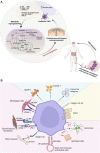Metabolic Reprogramming and Cell Adhesion in Acute Leukemia Adaptation to the CNS Niche
- PMID: 34957100
- PMCID: PMC8703109
- DOI: 10.3389/fcell.2021.767510
Metabolic Reprogramming and Cell Adhesion in Acute Leukemia Adaptation to the CNS Niche
Abstract
Involvement of the Central Nervous System (CNS) in acute leukemia confers poor prognosis and lower overall survival. Existing CNS-directed therapies are associated with a significant risk of short- or long-term toxicities. Leukemic cells can metabolically adapt and survive in the microenvironment of the CNS. The supporting role of the CNS microenvironment in leukemia progression and dissemination has not received sufficient attention. Understanding the mechanism by which leukemic cells survive in the nutrient-poor and oxygen-deprived CNS microenvironment will lead to the development of more specific and less toxic therapies. Here, we review the current literature regarding the roles of metabolic reprogramming in leukemic cell adhesion and survival in the CNS.
Keywords: CNS; acute lymphoblastic leukemia; acute myeloid leukemia; cell adhesion; central nervous system; meninges; metabolism.
Copyright © 2021 Sharma, Keewan and Matlawska-Wasowska.
Conflict of interest statement
The authors declare that the research was conducted in the absence of any commercial or financial relationships that could be construed as a potential conflict of interest.
Figures

Similar articles
-
The Role of the Central Nervous System Microenvironment in Pediatric Acute Lymphoblastic Leukemia.Front Pediatr. 2017 Apr 26;5:90. doi: 10.3389/fped.2017.00090. eCollection 2017. Front Pediatr. 2017. PMID: 28491865 Free PMC article. Review.
-
A narrative review of central nervous system involvement in acute leukemias.Ann Transl Med. 2021 Jan;9(1):68. doi: 10.21037/atm-20-3140. Ann Transl Med. 2021. PMID: 33553361 Free PMC article. Review.
-
Disrupting the leukemia niche in the central nervous system attenuates leukemia chemoresistance.Haematologica. 2020 Aug;105(8):2130-2140. doi: 10.3324/haematol.2019.230334. Epub 2019 Oct 17. Haematologica. 2020. PMID: 31624109 Free PMC article.
-
Central nervous system involvement in acute lymphoblastic leukemia is mediated by vascular endothelial growth factor.Blood. 2017 Aug 3;130(5):643-654. doi: 10.1182/blood-2017-03-769315. Epub 2017 May 26. Blood. 2017. PMID: 28550041
-
Central nervous system involvement in adult acute lymphoblastic leukemia.Hematology. 2008 Oct;13(5):293-302. doi: 10.1179/102453308X343374. Hematology. 2008. PMID: 18854093 Review.
Cited by
-
Glutamine and leukemia research: progress and clinical prospects.Discov Oncol. 2024 Aug 31;15(1):391. doi: 10.1007/s12672-024-01245-0. Discov Oncol. 2024. PMID: 39215845 Free PMC article. Review.
-
The significance of CD49f expression in pediatric B-cell acute lymphoblastic leukemia.Am J Clin Pathol. 2025 Feb 12;163(2):169-177. doi: 10.1093/ajcp/aqae105. Am J Clin Pathol. 2025. PMID: 39259664 Free PMC article.
-
Regulation and Functions of α6-Integrin (CD49f) in Cancer Biology.Cancers (Basel). 2023 Jul 2;15(13):3466. doi: 10.3390/cancers15133466. Cancers (Basel). 2023. PMID: 37444576 Free PMC article. Review.
References
Publication types
Grants and funding
LinkOut - more resources
Full Text Sources

